This document defines and describes different types of natural and man-made disasters. It discusses natural disasters such as earthquakes, volcanic eruptions, floods, droughts and tornadoes. It also covers man-made disasters and technological hazards that can result in accidents and damage. The document emphasizes that while hazards occur naturally, it is the combination of hazards and human vulnerability through factors like poor planning and construction that turn hazards into disasters, especially in developing countries that face greater losses and casualties from disasters proportional to their GDP.
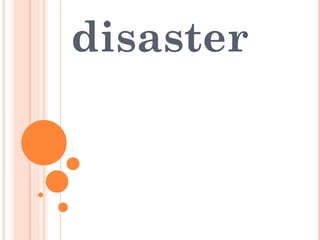

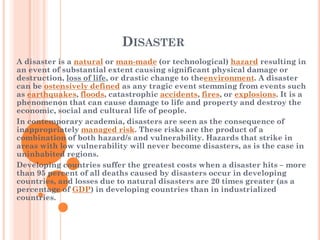


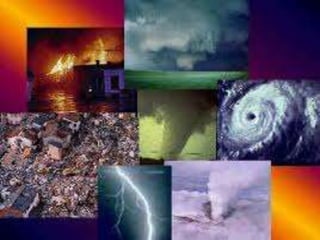
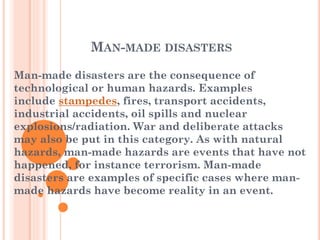



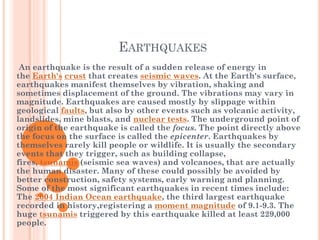

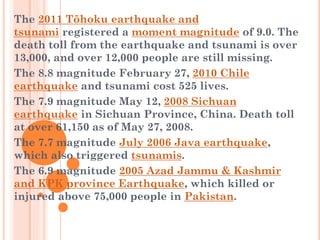

![VOLCANIC ERUPTIONS
Volcanoes can cause widespread destruction and consequent disaster in several
ways. The effects include the volcanic eruption itself that may cause harm following
the explosion of the volcano or the fall of rock. Second, lava may be produced during
the eruption of a volcano. As it leaves the volcano, the lava destroys many buildings
and plants it encounters. Third, volcanic ash generally meaning the cooled ash may form a cloud, and settle thickly in nearby locations. When mixed with water
this forms a concrete-like material. In sufficient quantity ash may cause roofs to
collapse under its weight but even small quantities will harm humans if inhaled.
Since the ash has the consistency of ground glass it causes abrasion damage to
moving parts such as engines. The main killer of humans in the immediate
surroundings of a volcanic eruption is the pyroclastic flows, which consist of a cloud
of hot volcanic ash which builds up in the air above the volcano and rushes down
the slopes when the eruption no longer supports the lifting of the gases. It is
believed that Pompeii was destroyed by a pyroclastic flow. A lahar is a volcanic
mudflow or landslide. The 1953 Tangiwai disaster was caused by a lahar, as was the
1985 Armero tragedy in which the town of Armero was buried and an estimated
23,000 people were killed .
A specific type of volcano is the supervolcano. According to the Toba catastrophe
theory 75,000 to 80,000 years ago a super volcanic event at Lake Toba reduced the
human population to 10,000 or even 1,000 breeding pairs creating a bottleneck in
human evolution.[8] It also killed three quarters of all plant life in the northern
hemisphere. The main danger from a supervolcano is the immense cloud of ash
which has a disastrous global effect on climate and temperature for many years.](https://image.slidesharecdn.com/disaster-131130235207-phpapp02/85/Disaster-15-320.jpg)

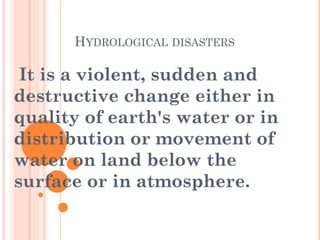

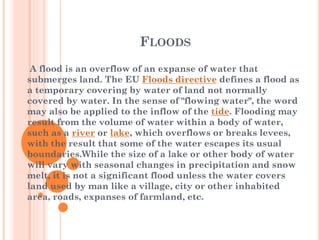








![TORNADOS
A tornado is a violent, dangerous, rotating column of air that is in contact
with both the surface of the earth and a cumulonimbus cloud or, in rare
cases, the base of a cumulus cloud. It is also referred to as a twister or
a cyclone,[12]although the word cyclone is used in meteorology in a wider
sense, to refer to any closed low pressure circulation. Tornadoes come in
many shapes and sizes, but are typically in the form of a visible condensation
funnel, whose narrow end touches the earth and is often encircled by a cloud
of debris and dust. Most tornadoes have wind speeds less than 110 miles per
hour (177 km/h), are approximately 250 feet (80 m) across, and travel a few
miles (several kilometers) before dissipating. The most extreme tornadoes
can attain wind speeds of more than 300 mph (480 km/h), stretch more than
two miles (3 km) across, and stay on the ground for dozens of miles (perhaps
more than 100 km).[13][14][15]
Well-known historical tornadoes include:
The Tri-State Tornado of 1925, which killed over 600 people in the United
States;
The Daulatpur-Saturia Tornado of 1989, which killed roughly 1,300 people in
Bangladesh.](https://image.slidesharecdn.com/disaster-131130235207-phpapp02/85/Disaster-28-320.jpg)

